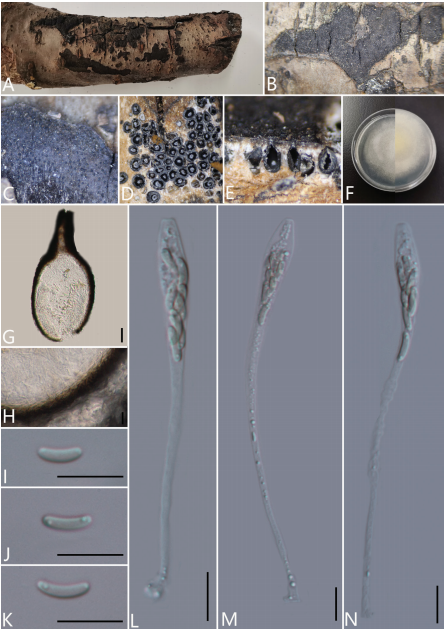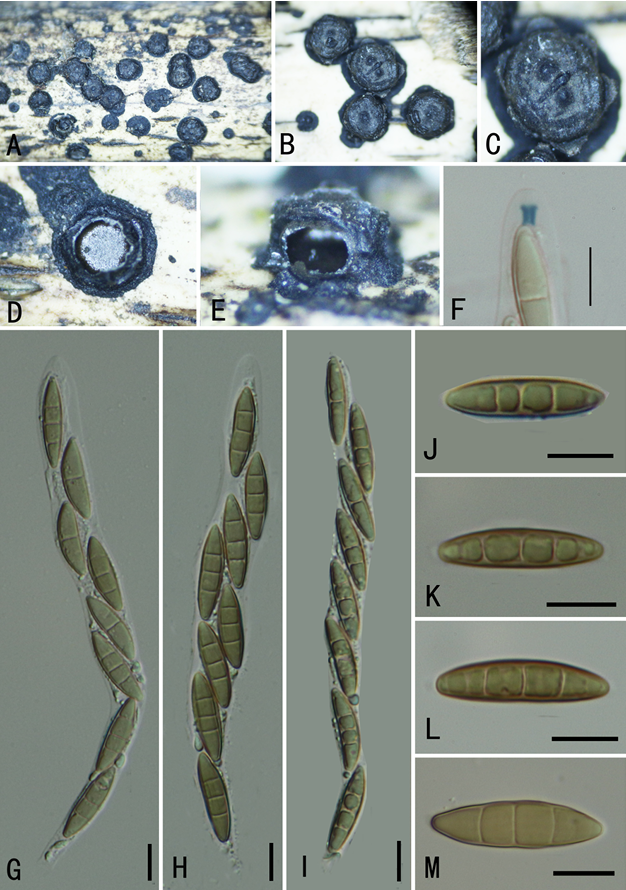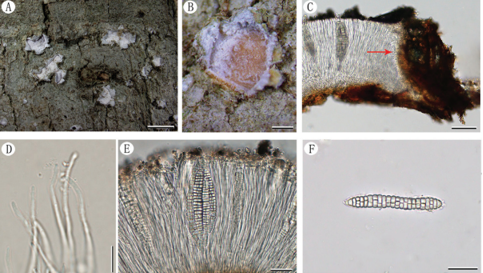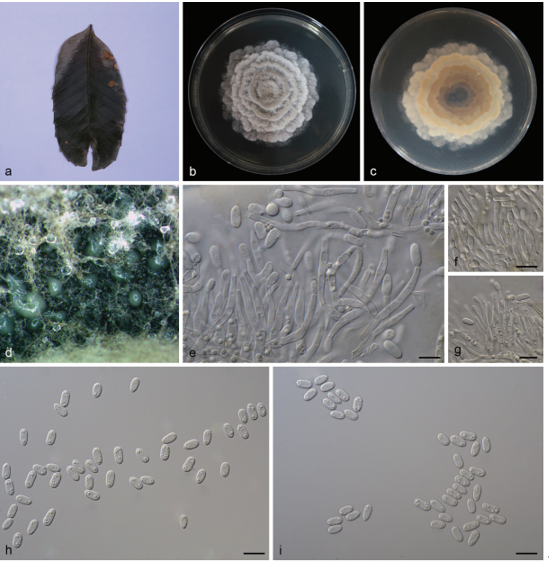Eutypa cerasi S.H. Long & Q.R. Li, sp. nov.
Mycobank No: 839657
Holotype. GMB0048.
Description. Saprobic on decaying branches of Prunus cerasus.
Sexual morph: Stromata immersed in bark, covering surface of host, irregular in shape, widely effused, flat, margin diffuse, surface dark brown to black, with punctiform ostioles scattered at surface. Endostroma consists of an outer layer of black, small, dense, thin parenchymal cells and an inner layer of white, large, loose parenchymal cells. Perithecium semi-immersed in stroma, globose to subglobose, glabrous, with cylindrical neck, brevicollous 203–304 μm high, 346–477 μm diam. (av. = 408 × 250 μm, n = 10), ovoid, obovoid to oblong. Ostiole opening separately, papillate or apapillate, central. Peridium 30– 50 μm thick, dark brown to hyaline with textura angularis cell layers. Asci 83.2–120 × 5.1–8.2 μm (av. = 104.4 × 6.3 μm n = 30) 8–spored clavate, unitunicate, rounded to truncate apex, apical rings inamyloid. Ascospores 7.3–9.9 × 1.4–2 μm (av. = 8.5 × 1.7 μm, n = 30), overlapping, allantoid, slightly curved, subhyaline, smooth, aseptate, usually with oil droplets.
Asexual morph: undetermined.
Culture characteristics. Ascospores germinating on PDA within 24 hours. Colonies on PDA, white when young, became pale yellow, irregular in shape, medium dense, flat or effuse, white from above, reverse white at margin, pale yellow at centre, no pigmentation produced on PDA medium, no conidia observed on PDA or on OA media.
Distribution: China
GenBank: GMB0048 (LSU: MW797048, RPB2: MW814894); GMB0049 (LSU: MW797049, RPB2: MW814895).
Notes. Eutypa lata is an important pathogen that has a wide range of hosts. However, the classification of E. lata is confusing because there are many variants in previous studies; now all are classified as E. lata (Index Fungorum 2020). Morphologically, the new collection GMB0048 has similar stromata with Eutypa lata, but the ascomata of the new collection are smaller than the ascomata (400 μm diam.) of the original description of E. lata (Tulasne & Tulasne, 1863). The ascomata and asci of the new collection are smaller than the ascomata (400–600 μm
diam.) and asci (110–180 × 5–7 μm) of the description of E. lata (Rappaz 1987). Additionally, in the phylogenetic analyses, E. cerasi is located on a branch that forms a sister clade with EP18 and RGA01 and CBS 290.87 basal to E. cerasi. Therefore, combining phylogenetic and morphological analyses, we introduce Eutypa cerasi as a new species of Eutypa.
Preference: Long, S., Liu, L., Pi, Y., Wu, Y., Lin, Y., Zhang, X., Long, Q., Kang, Y., Kang, J., Wijayawardene, N. N., Wang, F., Shen, X., & Li, Q. (2021). New contributions to Diatrypaceae from karst areas in China. MycoKeys, 83, 1–37. https://doi.org/10.3897/mycokeys.83.68926

Eutypa cerasi (GMB0048, holotype) A stromata on host substrate B, C close-up of stroma D transverse section through ascostroma E vertical section through ascostroma F culture on PDA G section through the ascostroma H peridium I–K ascospores L–N asci. Scale bars: 20 μm (G); 10 μm (H–N).









